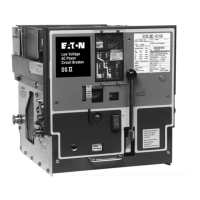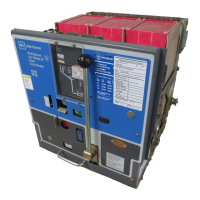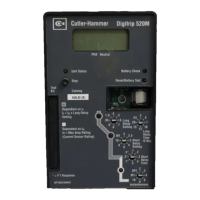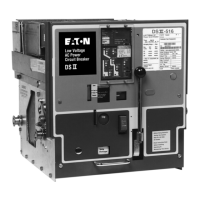Page
36
operated breakers automatically runs and charges
the closing springs.
4.
The breaker can be closed manually or electrically
after the springs are charged.
5.
The breaker can be opened (tripped) manually
or
electrically through a shunt trip device.
6.
The trip flap on the breaker compartment door will
not trip the breaker.
7.
The breaker must be opened before further levering
can be done.
8.
Overload tripping characteristics and other tripping
system functions can be visually checked and/or
changed
in
this position. All trip unit testing can be
carried out
in
this position.
4-5.4
CONNECT POSITION
In
the CONNECT position, the breaker's primary and
secondary disconnecting contacts are both engaged
with their stationary counterparts
in
the breaker com-
partment.
This is the farthest position from the front of the com-
partment into which the breaker can be levered. The
CONNECT position is indicated by:
1.
The drawout position indicator on the front of the
breaker
2.
A sudden mechanical stop is felt
in
the form of an
increase
in
load on the levering crank handle
NOTICE
When levering in
from
the TEST position, an
increase in load on the
crank
handle
is
felt
as
the
main disconnecting contacts are engaged. As
cranking
is
continued, the load will decrease some
and then suddenly increase, as the final connected
position
stop
is
reached.
In
this position, all the conditions listed for the TEST
position exist, except:
1.
IN
THIS POSITION, DO NOT ATTEMPT TO ELEC-
TRICALLY CHECK THE ELECTRONIC TRIP
DEVICE WITH A TEST KIT OR ANY OTHER
METHOD, SINCE THE BREAKER WILL BE
l.B.
694C694-02
TRIPPED AND CAUSE A DISRUPTION
OF
SER-
VICE.
2. The trip flap on the breaker compartment door is
operative, and can be used to trip the breaker with
the door closed.
4-5.5
MECHANICAL INTERLOCKING SYSTEM
OPERATION
Figure 4-11 shows that part of the interlock system
which prevents closing of the breaker while being driven
in
either direction by the levering device,
or
while it is
standing
in
any intermediate position between TEST
and CONNECT or DISCONNECT. Figure 4-11a shows
the shutter and trip plate for normal operation, such as
in
the DISCONNECT, TEST,
or
CONNECT positions.
The breaker can be closed and tripped open
by
all avail-
able devices
in
the latter two positions, except for the
trip flap on the breaker compartment door.
In
Figure 4-11a, the shutter prevents pushing the lever-
ing device crank handle onto the worm shaft. If the shut-
ter alone is pushed downward, it will rotate slightly about
its pivot pin and its lower projection strikes the hook on
the trip plate, and the worm shaft will not be cleared.
Therefore, it is necessary to push the trip plate in, which
moves the hook back out of the way of the shutter lower
projection. This permits the shutter to be pushed down-
ward to clear the worm shaft for the levering device
crank (Figure 4-11b).
It should
be noted that pushing the trip plate
in
also
pushes the trip shaft pin so as to rotate the trip shaft
counterclockwise, thus tripping the breaker open. If clos-
ing is attempted with the linkage
in
a position as shown
in
Figure 4-11 b, a trip-free operation will occur.
Movement of the shutter is also controlled by the inter-
lock cam which is mounted on the levering device shaft
to the left of the worm gear. The interlock cam has a
fixed relationship to the levering device arms. Figure 4-
12 shows the relationship between the shutter, interlock
cam and levering device arms for the four basic posi-
tions of the drawout unit
in
the compartment.
Figure 4-12a shows the CONNECT position. The cam is
in
a position to allow free travel of the shutter interlock
pin. Therefore, the shutter can be pushed downward,
but only after pushing in the trip plate (Figure 4-11). This
trips the breaker and prevents levering out with the
breaker closed.
Figure 4-12b shows the TEST position. Note that
between the CONNECT and TEST positions the cam
Effective
07
/97
Courtesy of NationalSwitchgear.com

